Future federal rules to protect right whales will very likely prohibit the use of traditional gear with buoy lines in certain areas of the Gulf of Maine, so it is critically important that fishermen participate in alternative gear testing. Without industry's participation in testing, alternative gear technology could be approved by NOAA for use in those areas that does not work for Maine fishermen.
To ensure an understanding of the capabilities and challenges of different technologies DMR plans to work collaboratively with industry to conduct extensive testing on alternative gear. Testing will focus on acoustic on-demand systems as well as other, less expensive, technologies such as timed-release and spring-tag technologies.
The goal is to gather data from licensed harvesters to evaluate which systems can cost-effectively minimize risk, work consistently in the variety of conditions fishermen face, and support enforcement needs for gear location and retrieval.
Testing will also evaluate the impact of different alternative technologies on the amount of time spent deploying alternative gear compared to traditional gear.
DMR will also launch the Maine Innovative Gear Library to ensure that Maine fixed gear fishermen have access to different gear types for testing, at no cost.
DMR will reimburse fishermen for participating in gear testing to compensate them for lost harvest time.
Alternative Gear Research
To quantify the risk reduction of different alternative gear types, and to provide a real world understanding of their capabilities and challenges, DMR will collaborate with industry to test and evaluate alternative gear retrieval technologies including on-demand systems and less expensive options like spring-tag and timed-release systems, as well as sub-sea gear location technology.
Gear Retrieval Technology
This project will outfit fixed gear fishermen with either a spring release or electronic timed-release systems, both of which are relatively low-cost options.
The spring release system connects a surface buoy, via whale-safe weak rope, to a spring near the connecting trap that releases under a pre-determined tension and opens a stowed mesh bag of line strong enough to retrieve the trawl of traps.
The electronic timed-release system is an electronic mechanism that allows fishermen to program the release of a stowed surface buoy and line connected to a trawl at a desired interval, e.g., 72 hours.
Fishermen will fish each system for one year and document their experience and differences between the systems.
Gear Location Technology
Sub-sea gear location technology is essential for alternative retrieval systems to work. It must allow lobstermen to locate and recognize their own gear and it must allow other fishermen in both fixed and mobile gear fleets to see and avoid lobster gear on bottom.
It must also allow enforcement to locate gear and retrieve it to ensure compliance with conservation laws.
Testing will determine the differences between traditional surface buoy systems and alternative sub-sea gear location technology in helping fishermen locate gear. The testing of alternative retrieval and gear location systems will produce information on risk reduction achieved by the systems, and the reliability of the technology. It will also provide an opportunity for fishermen to participate in the evaluation of these systems and to provide feedback on the feasibility of the technology.
Maine Innovative Gear Library
The Maine Innovative Gear Library will provide Maine fixed gear fishermen free access to different gear types to test, at no cost. The Library will support real-world testing by fishermen of a broad range of alternative gear technologies, and support an understanding of the capabilities, and challenges, of these technologies.
Participation in the Library will provide fishermen a chance to give feedback to manufacturers to ensure that the gear works for their operations.
The Library will include on-demand systems as well as other less expensive technologies which substantially reduce risk but may not represent zero risk, such as electronic timed-released systems.
Gear will be loaned to commercial fishermen recruited to integrate new gear within their existing operations, with enough gear to cover two trawls per participating fisherman. Participating fishermen must be at least 18 years of age.
Testing will allow DMR to quantify the risk reduction of each gear type, and to examine where and at what scale these alternatives may be necessary and operational. Testing will also evaluate the impact of alternative gear use on time spent deploying and retrieving traps compared to traditional gear.
Data from fishermen will be collected by Regional Hubs served by the Island Institute, Maine Center for Coastal Fisheries, Maine Coast Fishermen’s Association, and the Gulf of Maine Lobster Foundation and sent to DMR monthly for database entry.
Testing will occur offshore of Maine counties with fishing communities adjacent to Lobster Management Area 1: York, Cumberland, Sagadahoc, Lincoln, Knox, Waldo, Hancock, and Washington
Federal Experimental Fishing Permits and a Maine special license will be required for fishermen to test ropeless gear.
Fishermen will be compensated for participation at the following rates:
|
BASE RATES |
|||
|
Vessel Length (ft) |
Testing While Fishing |
No fishing (Research Day) |
Training |
|
<30 ft |
$400 |
$1920 |
$480 |
|
30-50 ft |
$450 |
$2160 |
$540 |
|
>50 ft |
$500 |
$2400 |
$600 |
Please follow this link to request participation in DMR's gear research or gear library.
Gear types available for testing are as follows:
Lift Bag/Acoustic Release (On-Demand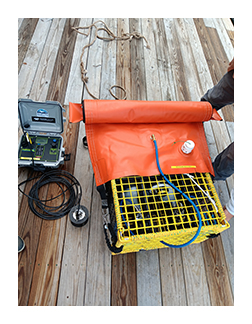 )
)
This gear uses an acoustic signal from the vessel to trigger a release that fills a bag with CO2 and lifts the device to the surface for retrieval. The bag must be deflated on the vessel for re-arming prior to setting gear. DMR currently has one model of this type, with 2 options for acoustic communications.
Stowed Rope/Acoustic Release (On-Demand) 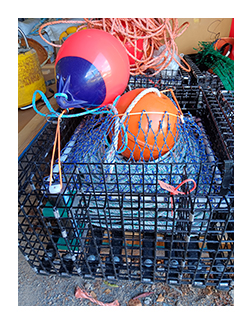
This gear uses an acoustic signal from the vessel to trigger a release that allows stowed rope to float to the surface for retrieval. The rope must be re-packed and release reset for re-arming prior to setting gear. DMR has currently two models of this type, each with their own acoustic communications.
Stowed Rope/Timed Release 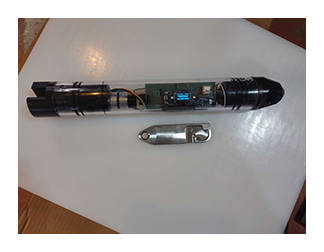
This gear uses an electronic timer to trigger a release that allows stowed rope to float to the surface for retrieval. The rope must be re-packed and release re-programmed for re-arming prior to setting gear. DMR currently has one model of this type.
Stowed Rope/Spring Release 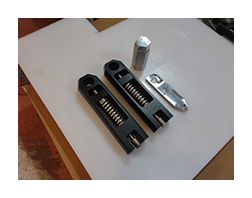
This gear uses a weak or small-diameter endline to trigger a spring release that allows stowed normal-diameter rope to float to the surface for retrieval. The rope must be re-packed and release re-armed prior to setting gear. DMR currently has one model of this type.
Gear Beacon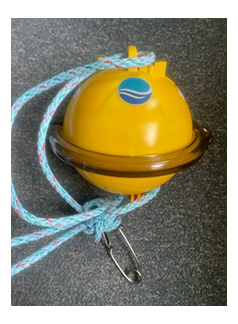
This gear uses a float with satellite connection to alert the owner to the surfacing or movement of gear while providing a constantly updated location. This technology can assist owners in finding gear in low visibility conditions or if gear shifted from its previous location due to weather or otherwise.
For more information on DMR's Alternative Gear Research and Library, please email DMRGearLibrary@maine.gov
Please follow this link to request participation in DMR's gear research or gear library.